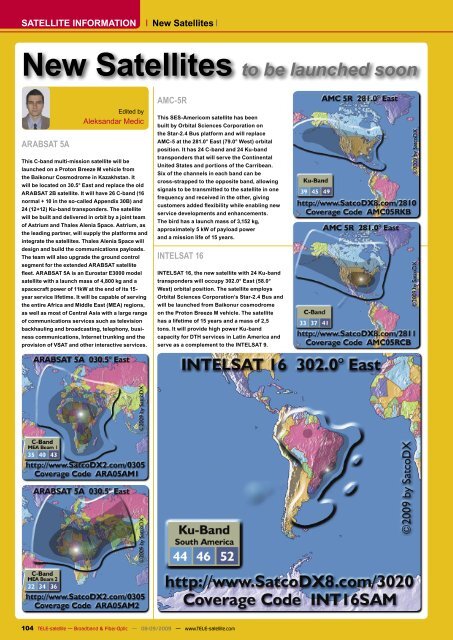08-09 - TELE-satellite International Magazine
08-09 - TELE-satellite International Magazine
08-09 - TELE-satellite International Magazine
You also want an ePaper? Increase the reach of your titles
YUMPU automatically turns print PDFs into web optimized ePapers that Google loves.
SATELLITE INFORMATION<br />
New Satellites to be launched soon<br />
ARABSAT 5A<br />
Edited by<br />
Aleksandar Medic<br />
This C-band multi-mission <strong>satellite</strong> will be<br />
launched on a Proton Breeze M vehicle from<br />
the Baikonur Cosmodrome in Kazakhstan. It<br />
will be located on 30.5° East and replace the old<br />
ARABSAT 2B <strong>satellite</strong>. It will have 26 C-band (16<br />
normal + 10 in the so-called Appendix 30B) and<br />
24 (12+12) Ku-band transponders. The <strong>satellite</strong><br />
will be built and delivered in orbit by a joint team<br />
of Astrium and Thales Alenia Space. Astrium, as<br />
the leading partner, will supply the platforms and<br />
integrate the <strong>satellite</strong>s. Thales Alenia Space will<br />
design and build the communications payloads.<br />
The team will also upgrade the ground control<br />
segment for the extended ARABSAT <strong>satellite</strong><br />
fleet. ARABSAT 5A is an Eurostar E3000 model<br />
<strong>satellite</strong> with a launch mass of 4,800 kg and a<br />
spacecraft power of 11kW at the end of its 15year<br />
service lifetime. It will be capable of serving<br />
the entire Africa and Middle East (MEA) regions,<br />
as well as most of Central Asia with a large range<br />
of communications services such as television<br />
backhauling and broadcasting, telephony, business<br />
communications, Internet trunking and the<br />
provision of VSAT and other interactive services.<br />
New Satellites<br />
AMC-5R<br />
This SES-Americom <strong>satellite</strong> has been<br />
built by Orbital Sciences Corporation on<br />
the Star-2.4 Bus platform and will replace<br />
AMC-5 at the 281.0° East (79.0° West) orbital<br />
position. It has 24 C-band and 24 Ku-band<br />
transponders that will serve the Continental<br />
United States and portions of the Carribean.<br />
Six of the channels in each band can be<br />
cross-strapped to the opposite band, allowing<br />
signals to be transmitted to the <strong>satellite</strong> in one<br />
frequency and received in the other, giving<br />
customers added flexibility while enabling new<br />
service developments and enhancements.<br />
The bird has a launch mass of 3,152 kg,<br />
approximately 5 kW of payload power<br />
and a mission life of 15 years.<br />
INTELSAT 16<br />
INTELSAT 16, the new <strong>satellite</strong> with 24 Ku-band<br />
transponders will occupy 302.0° East (58.0°<br />
West) orbital position. The <strong>satellite</strong> employs<br />
Orbital Sciences Corporation’s Star-2.4 Bus and<br />
will be launched from Baikonur cosmodrome<br />
on the Proton Breeze M vehicle. The <strong>satellite</strong><br />
has a lifetime of 15 years and a mass of 2,5<br />
tons. It will provide high power Ku-band<br />
capacity for DTH services in Latin America and<br />
serve as a complement to the INTELSAT 9.<br />
104 <strong>TELE</strong>-<strong>satellite</strong> — Broadband & Fiber-Optic — <strong>08</strong>-<strong>09</strong>/20<strong>09</strong> — www.<strong>TELE</strong>-<strong>satellite</strong>.com

















